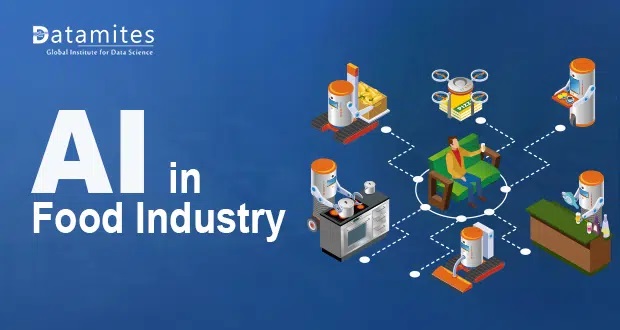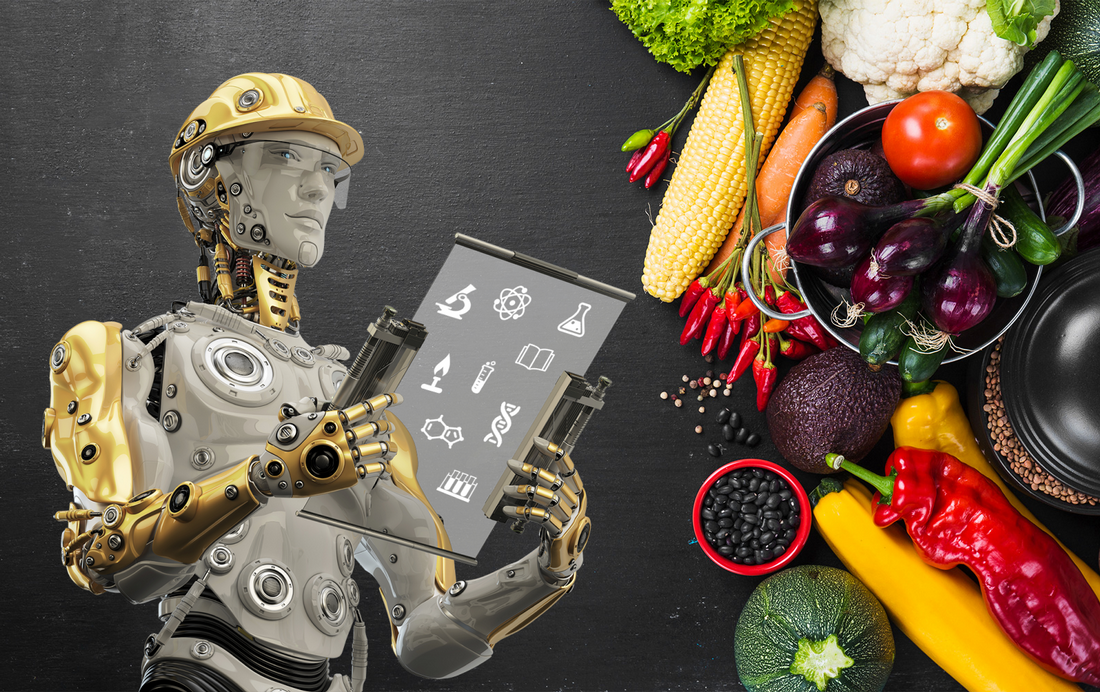AI In The Food Industry
What Are The Benefits, Challenges, And Applications?The application of AI in the evolving food retail sector is a sign to improve business and supply chain efficiency. These transformative technologies help food industry in a variety of retail segments through mechanisms, such as –
● Drone delivery
● Robots-driven sanitation programs
● Automated online order fulfillment
● Automated check-out
● Product shelf-life algorithms
Food Companies Taking Advantage Of AI-Powered Innovations

AI drives valuable contributions to food companies, including top-notch brands and entrepreneurial visionaries. For example, Nestlé and Nuritas use AI to identify proteins that enable production of healthy foods. Kraft Heinz is using AI to optimize and enhance its relationships with stores, sales reps, and consumers.
Domino’s is choosing AI technology to optimize its phone orders of pizza.
Wingstop, a global chain of restaurants in America, is reportedly using artificial intelligence to automatically answer orders received via phone calls. Now the company is going to create a virtual ordering assistant to facilitate attending multiple phone calls simultaneously, apart from assisting customers with recommendations resonating with their preferences.
Experts believe that AI-powered solutions built through AI software development will result in a drastic surge in operational excellence of businesses in the food industry. The food companies will be able to prioritize orders based on routing, channels, and in some cases by throttling orders.
A US-based food company is using AI to automatically answer customer orders received through phone calls. The company is in the process of creating a virtual ordering assistant that will answer multiple phone calls simultaneously.
Campbell Soup Company, for example, is taking advantage of AI technology to help with software product development. To understand what the customers want, the company is using AI-generated insights on behavioral patterns of customers.
In fact, the company believes that the assistance offered by AI has enabled it to understand that today’s customers crave spice. It has used that information and successfully launched products, like Spicy Chicken Noodle, Spicy Sirloin Burger, etc. to serve its target customers better.
Undoubtedly, food companies are doing a deep dive with AI and its subfield, Machine Learning. Experts believe that artificial intelligence is making an inroad to the food industry because leveraging these technologies is more like a journey to improve and expedite industry’s product innovation.
Do you know AI can create food recipes based on your dietary tastes and restrictions? According to the report, Yummy, an Estonian startup company, built an AI that can create food recipes based on customer’s preference. Moreover, it can also generate images of the dishes to be prepared.
The Necessity Of AI In The Food Industry
From automation to providing data-driven insights, the benefits offered by futuristic AI technologies accentuate their instrumental role in the food industry. It is now more noticeable, as the retail landscape shifts and food companies grow.
If you ask a reputed customized software development company, you get to know the power of AI. In fact, according to them, AI will help create highly customized and consumer-targeted content and information.
The technology is solving intricate problems in the food processing and improving business strategies to predict markets for products, reduce waste, and increase revenue by managing costs.

AI Components That Are Instrumental In The Food Industry
● Machine Learning
Machine learning basically teaches a machine how to learn automatically from the given training data and improves its performance from the learned experiences.
The machine then learns to predict things without being explicitly programmed. You can also say ML is defined as a scientific study of algorithms and statistical models, enabling computers to perform specific tasks without being programmed to do so.
Just as a young kid learns something by showing it multiple pictures of the object, ML learns in similar fashion, using patterns to identify an object.
Why ML in the food industry?
- Solutions based on machine learning can help food companies to estimate the demands for their products. As a result, companies can manage various tasks, like optimizing pricing, transportation, and inventory strategy.
- Machine learning solutions can efficiently automate rigorous and time-consuming processes, such as food sorting and packaging. It will save companies huge costs on human labor and expedite production.
- ML algorithms with data and can be utilized to identify debris and food particles to maintain food hygiene.
Natural Language Processing (NLP)
NLP basically enables computers to comprehend human communication, in terms of speech and texts. It’s a subfield of machine learning technology.
NLP-trained computers can interpret, manipulate, and understand human language based on data from multiple communication sources, such as emails, text message, video, audio, social media feeds, etc.
Later, NLP-powered AI software processes these types of data and learns patterns from them, like emotions, sentiments, intent, and responds to human communication in real-time. For example, ChatGPT uses the NLP model to generate convincing content based on prompts given by humans.
Why NLP in the food industry?
- Enables food companies to understand how customers talk about food and beverage.
- Helps you understand consumer behavioral patterns, like when they are eating and drinking, and when they indulge in activities not related to the food industry.
- NLP-powered chatbots can hold human conversation through websites or mobile phones, responding to their queries 24/7, with predefined answers.
- Food businesses can save their time and expenses by utilizing NLP to optimize their business processes. For example, automated chatbots handle customer queries and answers, thereby freeing up time for employees to focus on creative tasks, like generating leads, etc.
- Effective use of NLP eventually improves customer acquisition rate and revenue for food companies.
Computer Vision
Computer vision simply teaches computers to understand the visual worlds, using digital images, deep learning models to react to the objects it identifies and classifies. It is actually an automated system of interpreting visual data, instructing computers to comprehend the data on a pixel-by-pixel basis.
The way computer vision automates tasks is the same as what human visual systems do. To say otherwise, it interprets visual data in the same manner as people do.
Why Computer Vision In The Food Industry?
- Application of computer vision technology in the food industry improves the efficiency of food monitoring. It has encouraged the development of food safety, which is the core part of an intelligent process of food engineering.
- It enables automated and fully-hygienic inspection of a broad range of raw and processed foods.
- Computer vision system can precisely measure the diameter of a fruit in nano-seconds, a task that would be very hard for a person to perform with his naked eyes. This means computer vision can effectively and efficiently be useful in grading fruits based on image analysis. As a result, it will ensure an automated counting and sorting system of fruits, nuts, oysters, etc. in the food industry.
- A great application of computer vision in the food industry is visual inspection of package labeling. In it, the freshness of a packed product can be checked using special ink that changes its color with time and at a different speed, subject to the temperature.
Robotics
Robotics denote technical concepts dedicated to programmable machines called robots that substitute or replicate human actions. They are not the same as a robot.
The technology mainly focuses on developing robots and automation, whereas a robot is a machine programmed to complete a specific task.
In a broader term, robotics defines an engineering discipline that involves designing, building, and using robots and computer systems.


